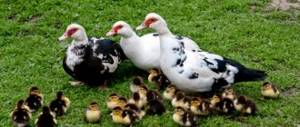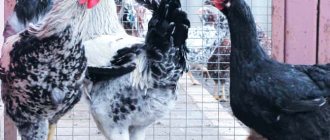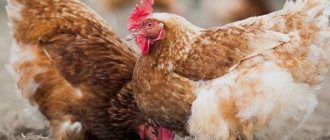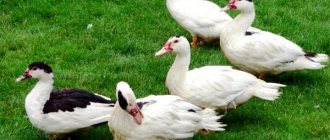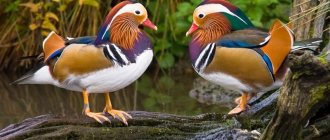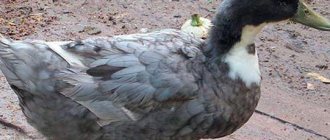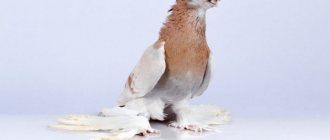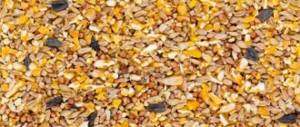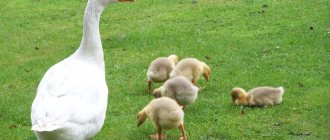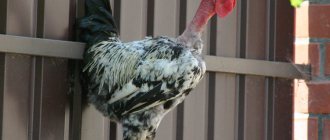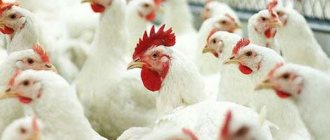Maintenance and breeding
Tufted ducks of all breeds are undemanding and unpretentious to living conditions due to the presence of genes from wild duck ancestors. In the duckling house, it is important to maintain cleanliness and temperature and humidity parameters.
If the room is dirty and too damp, the birds get sick and look bad. Russian corydalis are the most susceptible in this regard. Russian corydalis are the most susceptible in this regard.
Tufted ducks can be kept in aviaries and cages, but they feel better free-range.
You just need to provide them with a place where it will be warm and dry during bad weather. If this rule is not followed (the shelter is blown by winds or water drips from the roof), the birds will feel uncomfortable.
The proximity of an open pond will allow ducks to swim and splash in the water, which is their favorite pastime. If this is not possible, then it is necessary to place several containers of water on the bird-walking area. Even small vats and basins will do.
When breeding crested cats, special attention is paid to the persistent preservation of the main characteristic of the breed - the crest. Even if both crested parents are present, this trait does not always appear in the offspring. The crested gene accumulates gradually and little by little from generation to generation.
If during crossing the male or female did not have a feather cap on their head, then the ducklings will also be without it. Some of the offspring will receive a forked, saggy and ugly crest. Feather decoration becomes visible on newly hatched chicks
The crested gene accumulates gradually and little by little from generation to generation. If during crossing the male or female did not have a feather cap on their head, then the ducklings will also be without it. Some of the offspring will receive a forked, saggy and ugly crest. Feather decoration becomes visible on newly hatched chicks.
Selective selection is carried out constantly. A duck family is formed from individuals who have consistently retained their crested appearance in several previous generations. It is necessary to inject fresh blood by purchasing breeding material for breeding on the side.
Facts about duck farming
Tufted ducks love to splash in the water. Therefore, it is best to raise these birds in places where there is access to a body of water.
Crested ducks can easily be kept in an aviary, but then it would be advisable to build an artificial small pond or bathing area where the ducks will splash and clean their feathers
The presence of birds near water bodies significantly increases the number of fish. In winter, in good weather, birds can be released outside.
When breeding, you must adhere to a daily routine. During oviposition, there is no need to move birds to another home. The crested drake and the female can live peacefully with other poultry.
Nutrition
High-quality breeding is ensured, first of all, by proper nutrition, a varied diet and a sufficient amount of vitamins.
The diet should contain:
- corn;
- cracked wheat;
- special feed.
Birds get vitamins from eating greens: you can give them spores, duckweed, and bush onions.
[dzs_videogallery]
Keeping Tufted Ducks
Tufted ducks can also be kept in closed enclosures, but since they are an ornamental bird, they are usually bred in spacious ducklings, which are adjacent to equally large enclosures with ponds.
Tufted ducks need water
- Tufted ducks do not like crowding. There should be no more than 4 individuals per square meter of area. If there are more than 15 ducks in the room, then it is advisable to divide it into sections with special partitions.
- The room should be bright, with good ventilation, several light bulbs for additional lighting in winter. The most acceptable humidity for high productivity is 60-70%, temperature +16...+20 degrees. In winter it should not fall below +5 degrees Celsius.
- The bedding is made from hay, straw or sawdust, peat (can be combined). Change it when it gets dirty.
- The number or length of feeders should be sufficient for all birds. Approximately 15 cm of feeder is allocated for one adult.
- Not all tufted ducks need water, but it is still advisable to provide the bird with access to water, or at least a large trough of water so that the birds can splash around in it at will.
Subtleties of maintenance and care
It is possible to keep tufted ducks in spacious cages, but poultry houses with exercise pens and ponds are preferable. Birds do not do well when kept in crowded conditions. There should be less than 4 individuals per 1 m2 of poultry house. If the livestock includes at least 15 individuals, then it is recommended to divide it into groups, making a separate spacious block for each.
The poultry house must be illuminated, clean, and ventilated. Since late autumn, artificial lighting sources have been installed. Optimal air humidity is 60-70%, summer temperature is 18-20 °C, winter temperature should not fall below +5 °C.
The tufted duck can exist without swimming. But still, in the absence of a natural body of water, it is worth placing a pool or large basin with water near the poultry house so that the birds splash around. The bedding in the poultry house is made of straw, sawdust, or a mixture of these materials. Replace regularly with fresh ones. Feeders are installed so that each individual has at least 15 cm in length.
See also
Why does a duckling have a crooked or inverted neck and what to do, preventionRead
Breeds of wild ducks
Wild ducks primarily have a commercial purpose and are rarely used as ornamental ducks. The most famous representatives:
- Shoveler. A very peculiar bird, the distinctive feature of which is its wide beak. It prefers rivers among river bodies of water. Drakes have very beautiful plumage.
- Mallard. a very common variety. In our country it is found in most regions. Its close relative, the black mallard, lives in the Far East and Siberia.
- Pintail. Large birds with partly gray (chest and belly) partly brown (back and head) plumage in males and gray in females.
- Gray duck. Slightly larger than average for ducks.
- Wigeon. Medium size species. A special feature is the different sounds made by individuals depending on their gender. The male whistles and the females quack.
- Teal. It is divided into several subgroups, which include whistlers, codlings, as well as marbled or, otherwise, narrow-nosed teal.
- Killer whale. Range from Kamchatka to Eastern Siberia. A small bird weighing up to 800 grams.
- Mergansers. Birds with a narrow and curved beak. They live mainly in the forest zone. They are of medium size. Males weigh about 2 kg.
There is an even larger group of ducks distinguished by their method of obtaining food. They dive for fish. And, in fact, they are called diving. The most famous representatives: pochards, ducks and pink-headed ducks.
Crested duck breeds with photos
The breed group of Crested Ducks includes many breeds, the main distinguishing feature of which is the large lush crest on the head. These include wild crested ducks, mergansers, and domestic Dutch, Russian, Ukrainian, and Bashkir crested ducks.
The color of crested animals is very diverse and depends on the parent breeds involved in the crossing. In this case, a pattern is observed: the darker the main tone of the plumage, the richer the color of the beak and metatarsus.
[adsp-pro-4]
All crested breeds are not used for industrial breeding. Most often they can be found in zoos, on the personal farmsteads of lovers of exotic and ornamental breeds, and on specialized incubation and breeding farms.
Important! Purebred tufted ducks always show lower weight gain and egg production than their “parents”. The standard for crested breeds stipulates the weight of drakes up to 3 kg, ducks - 2-2.5 kg, the average egg production of crested breeds is 55-60 eggs, weighing no more than 80 g.
Bashkir Corydalis
Bashkir ducks are distinguished by their snow-white plumage.
Bashkir crested ducks descended from the Bashkir colored and Bashkir white breeds of ducks. In the process of breeding these domestic meat and egg breeds, Peking white ducks took part, which passed on the “crested” gene to them.
Bashkir ducks are one of the popular breeds in Russian poultry farming. They are distinguished by high early maturity, adaptability to harsh climates, unpretentiousness and good production qualities.
The characteristics of the Bashkir Corydalis largely coincide with the description of the breed qualities of the “parents”. First of all, this is an external resemblance:
- strong muscular body format;
- rounded, convex chest;
- wide-set legs with large paws;
- dense, short neck;
- flat, wide, slightly concave beak;
- strong wings that fit closely to the body;
- low carcass fat content;
- good taste of meat without a specific “duck” smell.
From ordinary Bashkir birds, crested birds have inherited elegant snow-white and variegated black and white colors, different shades of khaki with a characteristic “wild” plumage pattern.
Bashkirs are not highly productive.
In terms of production characteristics, Bashkir corydalis are inferior to their “parents”. However, farmers put up with their relatively low productivity and keep corydalis as decoration for their poultry yard.
Russian Corydalis
The Russian Crested Duck is valued all over the world for its beauty.
The Russian Corydalis is distinguished by its harmonious build and attractiveness.
When describing it, the most characteristic breed characteristics are usually indicated:
- compact, light, squat, raised in front body type with well-developed muscles;
- a slightly elongated rounded head on a slightly arched short neck;
- wide back with a slight convexity and slope towards the tail;
- a convex ribcage without a clear keel bone;
- voluminous, elastic belly without folds;
- dense, rich plumage adjacent to the body;
- fully feathered strong lower legs;
- medium-length crossing wings;
- horizontally set, wide tail;
- brown, lively, sparkling eyes;
- beak curved at the end;
- a large, fluffy, iridescent crest in the shape of a pom-pom crown made of thin, long feathers, several tones lighter than the main color;
- various colors: snow-white, black and white, multi-color;
- paws are bright orange.
Ukrainian Corydalis
The Ukrainian Corydalis has a beautiful, gray plumage color.
Ukrainian crested ducks most likely owe their origin to wild gray ducks and Ukrainian domestic ducks. This version is confirmed by their inherent color:
- dense, abundant brownish-gray, brown, white plumage decorated with “wild” patterns;
- the neck is white, rarely light gray, always decorated with a ribbon-necklace of a different shade;
- on the back, chest, sides, shoulders there is a pronounced scaly pattern, like a mallard duck;
- on the head, from the base of the beak, through the eyes to the back of the head, there runs a smoothly expanding stripe-mask of a dark tone.
[adsp-pro-5]
The physique, weight, and productive qualities of Ukrainian Crested Ducks are practically the same as those of Russian Crested Ducks.
Tufted duck
Tufted duck is of commercial importance.
The wild black-and-white tufted duck is common in the British Isles, Eastern and Northern Europe. Within the Russian Federation, it is found in Karelia, on the coasts of the Kola Peninsula, Taimyr, Kolyma, Anadyr, Kamchatka Islands, Sakhalin, in the Northern, Subpolar and Polar Urals, in Western Siberia, the Volga region.
The bird is tightly built. The live weight of the drake, depending on the season, is from 780 to 1200 g, ducks from 700 to 1100 g. Drakes have snow-white sides, belly and lower chest contrast with black head, neck, back, tail, like Gogol ducks. On the crown of the head, the elongated feathers are gathered into a flowing tuft-braid. Its length in a drake is 3-4 cm, in a female: 2-2.5 cm. There are small white specks on the feathers of the back, shoulders, and wings. On the wings there is a white mirror with a black border. The iris of the eyes is yellow, the paws are anthracite-black.
The Tufted Duck is an entertaining duck and is often purchased for garden decoration.
Females are painted a more modest dark brown color. The abdomen is white, with a small splash of brown feathers. The beak is lead-gray.
Attention! It has commercial significance. It is often bred to decorate city park ponds.
Another known wild tufted duck, distinguished by a long beak, is the long-nosed or tufted merganser. The medium-sized bird has an elongated beak in the shape of a flat awl, a black head with an emerald tint, decorated with a double raised crest.
Tufted duck
Medium sized duck. The body length of the drake is 47 cm, the female is 40 cm. The weight of the male is 800 g. The body weight of the female is 550 g. Tufted ducks live in temperate climates, but sometimes they can be found in the forest-tundra zone. Their habitat is wide: Iceland, England, Ireland, Germany, France, Poland, Ukraine, Kazakhstan, China, Japan. In Russia, ducks settle in the Lower Volga region, the Urals, Altai, and Transbaikalia. The bird is commercial:
- The breeding plumage of the drake is elegant. It's black and white;
- the head is dark with a greenish tint. A long crest hangs from the crown and back of the head. It is formed by thin, long feathers. The crest can be smoothed or fluffed. In females it is not as pronounced as in males;
- The iris of a duck's eye is bright yellow. The eyes stand out against the dark background of the plumage;
- back, neck and chest are black. The sides, wings and belly are white. The mirror on the wings is formed by wide, long, snow-white feathers;
- the beak is gray with a black dot at the tip. The beak has a flattened shape;
- females have brown plumage. After the spring molt, drakes become the same, but not for long. In autumn they again acquire an elegant, discreet color.
The tufted duck lives in large bodies of water with coastal vegetation. Ducks feed on algae, roots, and plant seeds. During the molting period, they catch crustaceans and mollusks. Sometimes small fish are eaten. Cherneti are good divers. To pick algae, they dive to a depth of more than 6 m. Moving underwater, they make rapid movements with their wings.
Birds become adults at 2 years of age. They form pairs and build nests. For nests they choose dense vegetation near a pond. They often organize a place for laying in thickets of reeds or reeds. The clutch consists of 11 eggs. The female incubates the offspring for 28 days.
More on the topic: What properties does a duck egg have?
The drake does not take part in hatching. Males organize flocks and fly away to other lakes, where they moult. After the appearance of new plumage, they return again to the females. By this time she already has offspring. The drake and the female begin to teach the chicks how to get food.
Russian Crested
Individuals of the Russian Crested breed, like Ukrainian ducks, have meat productivity. If they are bred for meat, then the young animals are used already at the age of 65 days. The chicks grow quickly and gain weight quickly. The male reaches 3 kg at 6 months. A tufted duck weighs 2.5 kg at six months:
More on the topic: How do ducks in the Moscow region live?
| № | Helpful information |
| 1 | The birds' plumage is completely white. The beak and metatarsals are bright yellow, without any colored spots |
| 2 | the head is proportional to the body. On the back of the head there is a growth on which fluff grows profusely. It forms a crest |
| 3 | The Russian Crested has a long, curved neck |
| 4 | the body is massive, with a wide back and chest |
| 5 | limbs are not widely spaced from each other |
| 6 | Ducks have long wings. The bird always holds them close to its body |
| 7 | Individuals mature at 8 months. The tufted duck lays up to 150 eggs per year, weighing 70 kg |
Ducks are kept on litter; they do not like cages. In summer, the livestock is free-range. A pen is set up for him on an area with vegetation. Be sure to feed the bird in the form of grain and mineral supplements. Ducks don't need a pond. A large basin with water is installed in the enclosure.
Breeding Features
Ducklings are born strong, with strong immunity.
Tufted ducks begin to lay eggs at 5-6 months. In a year they can lay about 120 eggs weighing 65-70 g. This type of duck can be bred either naturally or through an incubator. The chicks are born strong, with strong immunity. They grow very quickly, although breeders note that in winter the young animals slow down their development even with intensive feeding.
When breeding tufted ducks, individuals are sometimes born without a tuft. To ensure that the breed does not lose its species characteristics, only those individuals that have a crest should be left for breeding, and the rest should be discarded.
History of breeding of tufted ducks
It is impossible to say with complete certainty when tufted ducks appeared. Scientists believe that such individuals first appeared when the Chinese corydalis crossed with European poultry. For the first time, representatives of this species were brought to Europe (Holland) from Southeast Asia about 3 hundred years ago.
Important!
The egg production of tufted ducks can reach 120 eggs/year, while wild tufted ducks produce no more than 20 eggs per year.
For a long time, tufted ducks were bred in Holland, which is why they are often called “Dutch” ducks. In the 18th-19th centuries, corydalis began to spread throughout European countries. At the same time, new varieties of the crested type appeared.
Photo of Ukrainian Crested Duck
What types of ducks can be raised at home?
The duck family is divided into two large groups: domesticated varieties and wild ones. The former live only near humans, the latter mainly live in the wild, but if desired, they can also be kept in a farmstead. In turn, domestic species should be divided into 4 main classes:
- meat - large, fast-growing breeds with a solid body weight;
- egg-laying - produce more than a hundred eggs annually;
- universal - I demonstrate high achievements in both indicators;
- decorative - they have a bright appearance, and are grown to revitalize artificial reservoirs.
In each category there are a number of the most popular species that farmers breed most often
Table 1. Domestic species of ducks
| View | Breed |
| Meat | Moscow white Mulardy Rouen Musk Black white-breasted Favorite Peking |
| Oviparous | Indian runner Bashkir Khaki Campbells |
| Universal (mixed) types | Cayuga Swedish Blue Mirror Gray Ukrainian Orpington Saxon |
| Decorative | Carolina Shelducks Crested Maned Ducks |
Wild ducks include:
- Common mallards.
- Red-headed Pochards.
- Common goldeneyes.
- Killer whales (ducks).
- White-cheeked pintails.
Variety of species
How to choose the right option
Table 2. How to choose a breed?
| Illustration | Description |
| If the main goal is to raise large individuals for subsequent slaughter, then it is necessary to select representatives of meat species whose weight reaches 4 kg or more. | |
| If you plan to collect a lot of eggs, then you need to choose a breed with optimal egg production characteristics: 150-200 eggs per year (and even more). | |
| On a small farm it is more profitable to keep universal breeds. After the end of the reproductive period of females (after 2-3 years), it is possible to slaughter them and also obtain meat. | |
| In a small artificial pond it is worth placing several decorative individuals that are distinguished by their spectacular appearance. | |
| Wild ducks are also usually bred for ornamental purposes, but can also be kept for meat because they rarely get sick and require minimal care. |
Decorative breeds
In recent years, duck breeding has become increasingly popular, as they say, for the soul - so that waterfowl enliven artificial ponds and pools with their presence. For this purpose, varieties with a spectacular appearance are most often selected. Usually they are not of interest in terms of meat production due to their small mass - less than a kilogram (800-900 g).
Shelduck
Among the most common is the Shelduck duck, which is quite large: up to 68 cm in length and up to one and a half kilograms in weight. It can be recognized by its beautiful tricolor plumage and unusually shaped beak.
Shelduck
Mandarin duck
The multi-colored mandarin duck is one of the smallest in the family, its height does not exceed 50-55 cm. But due to its spectacular appearance, it can decorate any artificial pond.
Mandarin duck
Tufted duck
Tufted ducks are distinguished by a tuft of feathers on their heads, which is how they get their name. Their plumage can have different colors. Including snow-white or completely black. They can be bred not only for decorative purposes, because adult individuals often grow up to 2 kg and produce up to 50 eggs annually.
Crested variety
What to feed tufted ducks
To feed corydalis, a balanced diet is prepared. It should contain grains, legumes, and corn. It is advisable to add rapeseed or sunflower cake and bran to the mash. Fresh mash is given approximately once a day. They are made from chopped vegetables, herbs. Without fail, yeast, meat and bone meal, fish meal, and salt are added to bird feed, at least in small quantities.
Important! If you let ducks out to swim in ponds, you can significantly reduce feed costs, because you don’t have to feed the birds during the daytime walk. In order for the food in the stomach of ducks to be digested well, it is necessary to pour crushed shells, fine gravel, and ground eggshells into a separate bowl for them.
They eat this mixture as needed.
In order for the food in the stomach of ducks to be digested well, it is necessary to pour crushed shells, fine gravel, and ground eggshells into a separate bowl for them. They eat this mixture as needed.
If the animals are not allowed to walk, they must be given food 4 times a day. In the evening and morning they give dry grain mixtures, and in the afternoon - wet vegetable mash. If the bird walks during the day, then you can feed the ducks 2-3 times a day, because the birds find a lot of fresh food while walking. The water in drinking bowls is changed as often as possible so that it does not have time to run out or become contaminated.
The tufted duck is considered one of the most beautiful domestic birds. The breed originated in the 17th and 18th centuries when farmers crossed ducks imported from China with local breeds. A characteristic feature is the crown-like crest growing on the back of the bird's head (sometimes called a horned duck). The species has a friendly and active character. Ducks have a clear voice and the sound can be heard far away.
The tufted duck has many subspecies. Among them are the merganser - duck with blackhead, domestic Russian, Dutch and Ukrainian. This variation is explained by the fact that duck is popular among poultry farmers and is widely used due to its unique appearance.
Crested duck breeds
Russian Corydalis
The Russian Crested Duck has many differences. It has distinctive decorative qualities and a funny appearance:
The Russian Crested Duck has a calm and peaceful character and is distinguished by great mobility. High egg production throughout the year, and the weight of a white or greenish egg reaches 70 g.
Russian Crested Duck is a popular breed for breeding at home.
Tufted ducks of the Russian breed are bred to produce tasty meat, healthy eggs and as decorative birds. There is a strange relationship - a decrease in productivity has been noticed in birds with large crests.
Features that distinguish this breed from other ducks
- Unpretentiousness.
- Not picky about food.
- An excellent opportunity to live without ponds.
- The weight of the duck is 3-5 kg, and the meat is very tasty.
- The number of healthy eggs is up to 120 pieces.
- Ability to hatch well.
What do birds of this breed eat?
They eat whatever the owner gives them or whatever they get themselves. It can be dry ground greens, dry grain.
Russian Corydalis are unpretentious in their diet and love cleanliness.
Ukrainian Corydalis
This breed is similar to gray ducks, from which it differs in the presence of a tuft. It is bred not for its nutritional qualities, but as an unusual curiosity. She has:
- Variegated plumage adjacent to the body.
- The neck is decorated with a light circular stripe and is unusually curved.
- An oblong and rounded small head.
- Protruding cheeks.
- The color of the shiny eyes is dark brown.
- The beak is of medium length, slightly curved and raised.
- Strong paws set close together.
Crossing tufted ducks with other breeds has a negative impact on the condition of their tufts, which become split in two or droop.
Ukrainian corydalis are bred for decorative purposes.
Bashkir Corydalis
Bashkir ducks are early maturing, hardy and productive breeds of birds. Tufted ducks weigh less and are rarely found on farms. Their meat has a great taste, their eggs are healthy, as well as their unusual beautiful appearance were the reason for breeding. Bashkir Corydalis have:
- Convex breasts.
- Muscular body.
- The variegated coloring of the feathers has an attractive pattern that gives the birds sophistication.
Egg breeds of ducks
A bird with this breed weighs less than meat and all-purpose ducks. But their egg productivity is almost the same as that of egg-laying chickens.
Indian runners
Even a novice poultry farmer who has seen ducks of this breed at least once will not confuse them with its relatives. Why? The point is the uniqueness of the exterior of Indian runners.
They can be visually recognized by their narrow body (torso), positioning of the limbs (like penguins), small head and large wedge-shaped beak, thin and long neck, and raised tail feathers.
- The name of the breed itself says that we are talking about long-legged ducks.
- There are white, piebald, ash (various shades), and black runners.
- Live weight of representatives of the breed: drakes – 2 kg, ducks – up to 1.8 kg.
One of the obvious advantages of the breed is that in summer the bird gets by with an ordinary basin of water. In addition, such ducks tolerate harsh winters well and do not show aggression towards birds of other breeds and even species.
And now about the most important thing - egg productivity. Females are capable of producing more than 330 eggs annually. In many organoleptic properties, runner eggs are superior to chicken eggs. Their weight reaches 80 grams. Probably, the owners of egg chickens began to envy.
Although the breed does not shine with meat productivity, the meat of runners is harmless to people who are obese. There is very, very little fat in the meat (that’s why they are runners).
Popular meat varieties
Large breeds of ducks, which are bred for slaughter, are most in demand among farmers. These birds have very tender and tasty meat, which is considered a real delicacy. Maintaining even a large population of several dozen individuals is not too expensive, because waterfowl are omnivores, with good feeding they grow quickly and gain weight, so young animals can be slaughtered after 97-12 months.
Peking ducks
The leader in popularity is the Beijing variety
It combines all sorts of advantages that poultry farmers primarily pay attention to. Representatives of this breed extremely quickly reach a solid meat weight - 1.5-2 months after hatching
After three months, the birds weigh 3.6-4 kg and can be slaughtered. And this is even with a standard diet - ducks are not whimsical in this regard, regular feed is enough for them.
They also do not require any special conditions of detention, which is also a significant advantage. At the same time, the females also lay well - a little more than a hundred fairly large (90 g) eggs annually. The external characteristics of the Pekin are completely white (without markings) vestments, legs and beak of orange color.
Beijing variety
Black white-breasted duck
An interesting meat cross is the Black White-breasted ducks, obtained by scientists from the Ukrainian Poultry Research Institute, who combined the genes of the three largest varieties: Khaki Campbell, White Russian and Pekin. The result was a hybrid with meat of high fat content and solid weight indicators - 4-3.8 kg. The appearance of the birds is quite remarkable: a dense body with an open chest, powerful wings and back, and muscular legs.
The color is almost completely black, and there is a large white spot on the front of the body. Representatives of this breed grow quickly and can go to slaughter at the age of 3-4 months. The advantages include the high survival rate of young livestock - 96 individuals out of 100, omnivorousness and good immunity. A significant drawback is the low hatching percentage - 65 out of 100.
Representatives of the Black White-breasted variety
Mulards
The Mulard species belongs to the broiler class and is an artificially bred hybrid (based on the Peking and Musk variety). These are record holders among meat varieties, because young animals reach the 4 kg mark at three months of age, but do not stop there and continue to grow. The peak level is 6 and even 7 kilograms.
This species does not lay eggs well, and the hatching rate of ducklings is extremely low. This is a meat variety that can only be kept for the sole purpose of being slaughtered for meat.
Mulard ducks
Muscovy duck
Representatives of the Musk breed, also known as Indo-ducks, are endowed with a specific smell, since South America, the habitat of aboriginal Indian tribes, is considered their homeland. They are also very large birds, gaining weight up to 6 kg upon reaching sexual maturity.
It is better to slaughter young animals after 3 months - before the first molt, otherwise the meat may become tough. This species can be easily recognized by the characteristic pink warty growths on the beak and the adjacent part of the head. Indo-duck meat is dietary and contains very little fat, unlike other varieties.
Musk breed (Indochka)
Rouen duck
The Rouen variety is named after its place of origin, as it was developed in northern France. Breeders set out to create a meaty species with very high quality fillets that could be used in haute cuisine recipes.
In addition, when the calorie content of the diet increases, birds gain fat very quickly, which makes it possible to obtain from them extremely tender fillets with translucent fat, which is considered a special delicacy. The optimal weight for mature individuals is 5.3 kilograms.
Ducks from Rouen are famous for their variegated plumage, and the drakes have a bright emerald head and a white necklace.
Moscow white duck
The Russian breed, one of the most popular in our country, is the Moscow White. In appearance it resembles the Pekin, from which part of the genetic material for selection was borrowed. The second “donor” was the Khaki Campbell species. Individuals are quite large - 4.5 kilograms when reaching sexual maturity, and have tender, not fatty, but juicy and tasty meat.
This species is characterized by snow-white plumage without a hint of yellowness (which is characterized as culling) and a rich red beak color.
Moscow variety with white plumage
All about the Tufted Duck breed
Domestic ducks with large crests on their heads are one of the oldest breeds of ornamental birds, which have, incl. and some economic value.
There are several varieties of the breed, which differ in external characteristics and requirements for living conditions.
The tufted duck is light in weight, but has good egg production and a beautiful appearance.
Description and characteristics
Ducks that have a voluminous cap or crown of long, thin feathers form a breed group. All breeds that are part of the corydalis group are distinguished by similar external characteristics:
- Dimensions. Corydalis are small in size compared to Mulards or other meat breeds. The weight of the bird, depending on the variety, is 2-3 kg (for ducks) or 2.5-3.5 kg (for drakes).
- Body type. Despite their small size, crested birds are distinguished by well-developed muscles and dense build. The duck's body is elongated, its back is wide and long, and its chest is slightly convex and rounded. The neck of the corydalis is short and protrudes slightly forward. The beak is of medium or short length and oblong in shape. In some breeds it is slightly raised. The legs of ducks are short and powerful; the length and appearance of the wings depend on the type of breed.
- Plumage. The feathers of the corydalis are thick, dense and hard to the touch. The color of the bird depends on the parental genotypes. Common to the entire breed group is a direct relationship between the color intensity of the feathers and beak: ducks with dark colors have a brighter and darker beak.
- Manifestation of a gene in phenotype. The gene that determines the presence of a crest, the main breed characteristic, is manifested in the phenotype (appearance) of the duck in only 80% of cases. If one of the parents does not have a crest, the hatched ducklings will not have this feature.
- Productivity. The productivity of ducks is low: they can grow quickly, but the weight of an adult does not exceed 3-3.5 kg. Corydalis are often raised for their eggs. The productivity of birds inversely depends on the size of the crest: ducks with large feathered crowns are raised primarily for decorative purposes.
The Crested Duck is active, non-aggressive and mobile.
Ukrainian Crested Ducks
Also check out these articles
- What are the advantages of polycarbonate greenhouses
- Description of the breed Toulouse geese
- Calorie content of melon and beneficial properties
- Cucumbers in tomatoes for the winter
Ukrainian crested ducks are a type of crested duck, which, first of all, is distinguished by its large body weight - females weigh 3 kg, males weigh 3.5 kg. But the breed also has some other features:
- high egg production;
- precocity;
- birds love to fly.
Among the disadvantages, it can be noted that birds are prone to obesity if given a lot of food. And if the bird begins to gain fat quickly, the taste of the meat deteriorates.
Important!
To prevent individuals of the Ukrainian breed from flying far, they need to trim the feathers on their wings.
The physique is powerful. The neck is slightly curved. Legs are strong and set close. The head is almost round. The eyes are dark brown. The beak is small, raised. The main color of the feather is white, brown or brown-gray. There is a scaly pattern on the chest, and on the wings, back and neck the plumage is lighter with a pronounced horizontal stripe of a contrasting color.
Pros and cons of the breed
Tufted ducks have the following positive qualities:
- beauty of plumage;
- unpretentiousness in maintenance and feeding;
- edible and soft meat;
- ability to hatch eggs well.
A farmer who wants to breed this breed should also be aware of the shortcomings that are sometimes so acute in birds:
- low productivity;
- in ducks, signs of crestedness often disappear, therefore it is necessary to carry out constant selection work to preserve it;
- it is difficult to find ideal individuals for breeding and obtaining purebred chicks;
- the average egg production rarely exceeds 60 eggs per year from one duck;
- there is an urgent need to keep the birds’ home clean.
A decorative duck will be a good choice for decorating your yard. Its unusual appearance will add zest to any household.
1691Article ratingKira Stoletova
Among all the variety of birds, tufted ducks are considered one of the most spectacular. History says that they appeared as a result of crossing an overseas guest from China with European ducks. And for 300 years this breed has been decorating the lands of European and Russian farmers. The Russian crested bird is more decorative than meat. They call her crested because she has a cute crest on her head.
Tufted ducks
Answer or solution 1
According to the notation introduced in the problem statement, we write down the parent individuals.
Diheterozygous drake - AaBv. It produces spermatozoa av, av, av and av.
Heterozygous tufted duck with silk plumage - Aavv. For the gene that determines the development of silk plumage, this duck is necessarily homozygous, otherwise the trait could not be realized in the duck’s phenotype. The eggs produced by such a duck are Av and Av.
The offspring of these individuals will be represented by the following options:
Tufted ducklings with silk plumage (2 Aavv);
tufted ducklings with normal plumage (2 AaBv);
ducklings with silk plumage without crest (aavv);
ducklings with normal plumage without a crest (aaBv).
Ratio 2: 2:1:1.
Embryos with genotypes AAVb, AAbb will die.
Unified State Examination in Chemistry and Biology for 80+ entry is pinned
Are you taking biology?
Can you distinguish between dihybrid and crossing-over problems? Can't distinguish between cis- and trans-gene locations in a crossing-over task? Do you know that if you incorrectly substantiate evidence such as crossing, you will get 0 points even for a solved problem?!
What if you have gaps in your knowledge and you only realize it in the exam?
Did you know that already in 2021, the tasks in genetics are formulated in such a way that the usual dihybrid crossing for independent inheritance of traits, when using analyzing crossing, turns out to be not independent at all, but, on the contrary, linked?
If the previous questions and the next task from the demo version of the control measurement materials of the Unified State Exam 2021 do not raise any questions for you, feel free to close this text, you are ready for the Unified State Exam!
Assignment from the Unified State Exam 2019. In ducks, the traits of tufting and plumage quality are autosomal unlinked. In the homozygous dominant state, the crested gene causes the death of embryos. In crossing tufted ducks with normal plumage and tufted drakes with normal plumage, part of the offspring turned out without a tuft and with silky plumage. When crossing tufted ducks with normal plumage (homozygous) obtained in the first generation and drakes with the same genotype, two phenotypic groups of descendants were obtained. Make a diagram for solving the problem. Determine the genotypes of the parent individuals, the genotypes and phenotypes of the resulting offspring in the first and second crossings. Define and explain the phenotypic segregation in the first and second crosses.
Care
Russian Crested (chicken breed)
Ducks are unpretentious in keeping. They feed on any food, preferably dry grasses and grains.
Important: you can arrange a small pool for the birds in the aviary, this will have a positive effect on the mood of the entire flock. Ducks will frolic in it, dive, get food
Duck housing must be clean and dry. Dirt and dampness cause discomfort to the bird and can cause illness. The floor of the poultry house should be cast concrete or lined with brick. This will prevent moisture and dirt from penetrating inside. The floor must be covered with bedding. Sawdust, hay or straw are used for it. Everything is sprinkled in an even layer 5-10 centimeters thick. The exit from the house leads to a fenced enclosure where the bird spends most of its time.
If there are ducklings in the house, there is an urgent need to maintain a high temperature. When breeding ducklings at home, it is necessary to have heating equipment, which is installed in the poultry house.
The ducklings are fed as soon as they hatch and dry out once every two hours. For food you need to prepare porridge from crushed boiled eggs mixed with grain. Fresh greens are also necessary for chicks - any fresh grass is used.
Important: in order for the chicks to grow up healthy, you can give them cottage cheese soaked in whey
General information about the tufted duck
Despite its “royal” appearance, the tufted duck is unpretentious, even very modest in its living conditions. She eats whatever you give her without whims. If there is a body of water nearby, the bird will be happy to spend time in it. If it doesn’t happen, he won’t be too upset either. His absence should rather sadden you. After all, having a pond is a great way to save significantly on poultry feed.
Today, breeders do not pamper the beautiful Corydalis with their attention, and in vain. Although the good thing is that poultry farmers like this duck, and they are happy to support the development of the crested population on their farms and private farmsteads.
Combined breeds
If your plans include a small backyard farm, then this is your option for ducks. Due to their versatility, 2-month-old ducks weigh 1.5 kg.
Khaki Campbell
Representatives of this breed are the result of the work of an Englishman who worked on his selective herd in the 19th century. Plumage color options are brown and khaki. Drakes have heads, necks and chests that are colored differently than females.
You can also identify the bird by its dark green beak. It is noteworthy that with a somewhat elongated body, ducks of this breed have too short legs. We can talk about a certain disproportionality of development. The breed is good because it shows high productivity when fed algae and pasture grasses.
With a good food supply, males gain three kilograms of weight. And females weigh around two kg. Average egg production is 175 eggs per year.
Mirror breed
A bird of domestic selection, which was created on the basis of such breeds as Peking (maternal breed) and Khaki Campbell (paternal breed). The plumage color is light brown.
There is a white border on the chest of males. And on the wings there is a so-called “mirror”, which is how drakes differ from females. Day-old females are covered with light brown, males with grayish down.
A bird at the age of 2 months weighs 2 kg. The female produces 120 eggs per year.
Russian Corydalis
The Tufted Duck of Russian origin has excellent exterior qualities. Poultry farmers have long been happy to breed Russian corydalis in their backyards because of its funny appearance and excellent meat taste.
Bird of medium length. The rear part is more massive and slightly inclined towards the tail. A well-built body leaves an overall impression of grace, strong physique and excellent health. The duck's chest is rounded, with developed muscles, without a pronounced keel formation. The feather is thick, fits tightly to the body, and the colors vary from snow-white to variegated.
The feather is so long that it hides the bird's legs. The wings are also elongated, almost completely covering the body. On the oval-shaped head, the bird’s metatarsals are distinguished by the brightness of red-orange tones, turning into a slightly concave beak. The eye beads are shiny, dark brown.
The tufted duck cannot be confused with any other, even among the diversity of the bird flock. Of course, because of the crest, spherical, assembled from thin, neat feathers of an elegant shape. The color of the decoration always differs from the main plumage in lighter shades.
The corydalis drake weighs on average 2.5 kg, and the female weighs around 2 kg. The bird's egg is approximately 55-60 grams, and the bird's egg production is worthy of respect - it lays all year round.
The nature of ducks is very peaceful and non-conflicting. And although she herself is a rather frisky creature, she never provokes her friends into noisy bird fights.
This is interesting!
If one of the chicks’ parents did not have a crest on their head, then the offspring will also be born “uncrowned.”
Ukrainian Corydalis
Black duck - description, name
This breed has a lot in common with its Russian counterparts, but differs in small details:
- the neck is slightly curved;
- the head has a rounded-oblong shape;
- the eyes have a slight shine, the color is brown;
- the body is large, the weight is also appropriate;
- on the neck there is a strip of light feathers, reminiscent of a necklace;
- the beak is medium, has a slight bend;
- the paws are powerful, not too far apart from each other;
- the plumage is dense and bright. Closely adheres to the duck skin.
The Ukrainian Crested, like its Russian relative, also does not weigh much. The weight of the drake ranges from 2 to 2.5 kg, and the weight of the female does not reach 2 kg. They also lay eggs all year round. The weight of the egg is the same as that of the Russian breed - about 60 g. They are white in color, and occasionally there are eggs with a greenish tint.
The breed is not a meat breed, although it is sometimes used as food. Like its Russian relative, it is used for decorative purposes.
Bashkir Crested
The breed got its name due to the fact that it was bred on the territory of Bashkiria. The breed has the following characteristics:
- like the entire species, individuals have a large and powerful body;
- the chest plumage is dense and protrudes noticeably forward;
- the wings are powerful and strong;
- the comb is the same as that of other breeds;
- the color range is extremely wide. It ranges from black-brown (rarely red) to bluish colors.
The main reason for breeding this breed of ducks is that they mature very quickly and have tasty, tender meat. They have less weight compared to their Russian and Ukrainian relatives. Only low productivity is an integral companion of this subspecies. But it is more than compensated by the beauty of its plumage and affectionate character. The bird is used for decorative purposes, but can sometimes be eaten.
Features and differences of the breed
The Crested is considered a light and agile bird. It is non-aggressive and, despite its small size, has well-developed muscles. A description of ducks of this breed will be incomplete without mentioning their main feature - the tuft on the back of the head. It indicates the purebredness of the breed. It is also thanks to him that the crested bird has become so popular among fans of ornamental birds.
And it doesn’t matter what color the feathers on the crest are, the main condition is that they must be long and thin
The bird has a short but dense neck and a small beak. It has not very developed wings and limbs. Thick plumage complements the picture with a variety of colors. The color of the feathers depends primarily on where the duck lives, as well as on the manifestation of the blood of other breeds with which it was crossed. A notable point is that the darker the bird, the darker its beak.
Unfortunately, even when crested drakes and ducks are involved in breeding, about a fifth of the chicks are still born without crests. The whole question here is in genes: the lower the gene concentration tufted ducks have, the fewer purebred babies appear.
There is another feature of the breed - low weight. An adult male rarely reaches 3 kg, and a female weighs no more than 2 kg. The egg does not weigh more than 80 g. Most often, no more than 55 such eggs per year can be produced by one young individual. The recorded record for this breed was 120 pieces, but this is rather an exception.
Russian Crested Duck
The breed of duck with a tuft on its head was one of the first to appear. It is believed that Chinese Crested ducks and European ducks were originally crossed. Due to its characteristics, it is used as an ornamental bird.
A short description of this breed:
- very lush chest plumage;
- the keel bone does not stand out too much;
- the front part of the body is slightly raised;
- the wings are long compared to other breeds;
- the color of feathers is dominated by black and white, but sometimes multi-colored individuals are also found;
- the beak is large and concave in shape;
- there is a spherical crest on the head, the main feature of which is the light tint of the feathers;
- the lower legs are densely covered with feathers from top to bottom;
- the feathers adjacent to the body are shiny and also grow thickly;
- eye color is dark brown.
Russian Crested Duck
Ducks of this breed are friendly to humans. Despite their kindness, they have a very energetic character and are constantly on the move. The average weight of a male varies from 2.5 to 3 kg, and females rarely reach a weight of 2 kg.
Does not have high productivity. The number of eggs laid per year rarely exceeds 60. But sometimes there are individuals carrying up to 120 eggs. The duck lays eggs all year round, regardless of the season. The peak of activity falls in the first half of the year. The weight of the egg is around 60 g.
Description of the breed
Gray Ukrainian ducks have good immunity and appetite. They love freedom and cannot do without water. The active bird is constantly looking for food in the pasture and grows quickly.
Appearance
The gray Ukrainian duck has a beautifully built body. Its elongated body is slightly raised forward. The bird's muscles are well developed. She has a wide back and chest. There is no wedge-shaped process on the duck's belly. The head, set on a neck of medium length, has an oval shape. A distinctive feature of birds is their increased density of down. Based on the type of plumage color, birds are divided into:
- White. These ducks have white feathers and an orange or bright yellow beak.
- Clayey. Birds of this species have brown plumage, a green beak and red and orange paws.
- Wild feathered. The most common type. These ducks may have golden or chocolate brown plumage. Males have a white non-closed ring in the neck area and shiny blue-green feathers. In summer, males molt and become similar to females. The beak of wild-finned ducks has an olive color. There is a black spot at its tip. The bird's feet are orange.
- Gray. This type of duck is similar to the mallard. The backs of the birds are covered with feathers that have black and brown plumage. The wings of ducks and the lower part of the body are painted gray, the sides have a shiny blue tint.
Breed characteristics
The gray Ukrainian duck is a heavy meat breed. The average weight of an adult female is 3 kg, a male is 3.5-4.0 kg. Birds reach this weight by 4 months. At the age of 2 months, ducklings weigh about 2 kg. This is enough to start slaughtering them. The meat of young ducks is especially tender and soft.
The breed of gray Ukrainian ducks is characterized by rapid growth. The survival rate of ducklings is 95-97%. Adults have a large amount of fluff in their plumage. With proper nutrition and care, gray ducks can show good egg production results.
Features of behavior
Despite the great love of ducks for splashing in water, there is no need to build a large artificial pond for them. It is quite enough to provide deep troughs for them. Gray Ukrainian ducks have a very friendly character. They can do well with most types of pets. Large crowding of birds causes them anxiety, which leads to a decrease in egg production. It is recommended to place it on 1 sq. meter no more than 3 ducks.
Ukrainian gray ducks are very talkative. Their quacks can be heard far from their habitat. The drake's voice is very similar to the croaking of a crow. Females are more vocal. In warm weather, ducks try not to gather in flocks.
The main purpose
Gray Ukrainian ducks are a fast-maturing meat breed. At home, it is bred not only for meat. The bird flies well and produces a lot of fluff. It is used for stuffing pillows and feather beds. One of the species of this breed is the tufted duck. It is bred for decorative purposes due to its unusual appearance. The head of such a duck is decorated with a beautiful crest. The decorative nature of this species does not exclude the use of eggs and poultry meat for food.
Bashkir Crested breed
We recommend reading our other articles
- The best varieties of tomatoes for open ground
- How to fight late blight on tomatoes?
- Film for greenhouses
- Leasing of agricultural machinery: useful tips and recommendations
Photo of Bashkir Crested Duck
This variety of corydalis differs:
- increased endurance;
- high egg production;
- unpretentiousness.
At the same time, the disadvantages include the fact that Bashkir ducks can only be kept near water bodies, otherwise productivity decreases and the appearance and quality of feathers deteriorate.
Important!
In terms of body weight, Bashkir crested ducks are inferior to Ukrainian and Russian species. Because of this, they are less popular and are bred mainly by fans of this breed.
The bird's physique is powerful and its bones are strong. The chest is protruded and covered with soft, dense feathers. Legs are strong and set wide. The bird is distinguished by beautiful, large wings. The neck is of medium length, rather thick. The color of the bird comes in several types: white, black-brown, gray, gray, brown. The main feature of the species is the bright patterns on the wings.
Final part
We looked at the details and were convinced that tufted ducks have an extremely attractive appearance. Those who strive to obtain a large amount of meat from breeding ducks will not like such birds. But for aesthetes with delicate taste and for people who want to please and surprise guests and neighbors, the Russian Crested is an ideal option.
The uniqueness and sophistication, recognition and brightness of these birds will add a touch of chic to any farm or private household.
- https://fermerok.info/poroda-utok-hohlataya
- https://7ogorod.ru/domashnyaya-ptica/hohlataa-utka.html
- https://fermoved.ru/utki/hohlatye.html
Russian bird
There are several species of crested birds, which include the Russian crested, the Bashkir crested, the dusky, and the Ukrainian variety. Let's look at each of them in detail. The rarest and most endangered species of duck is the tufted shelduck. Little information has been collected about her. The only evidence of the existence of this breed is a few photographs. It is believed that it nests on mountain slopes. The crested shelduck is an endangered species listed in the Red Book.
The Russian crested bird is popular among farmers in Russia. Its main external characteristics include the following:
- average bird size;
- well-built body structure;
- dense and dense plumage, mostly white;
- long wings pressed to the body;
- dark eyes on an elongated head;
One of the main advantages of the Russian Crested Duck is its ability to lay eggs all year round.
Ukrainian Crested
This breed is practically indistinguishable from the common gray duck, except for the magnificent crest on the head. In fact, they breed it, rather out of curiosity for the outlandish decoration, rather than because of its special taste properties. But heredity to the fluffy “crown” is cumulative. If you do not control the selection process and do not engage in selection, the crest will eventually disappear in the yard bird offspring.
The feather of the Ukrainian corydalis is variegated, tightly pressed to the body. There is a high white collar around the neck. By the way, the neck itself is designed in such a way that at first glance it seems as if it is crooked. This is the natural appearance of the bird, given to it by nature. On the head of an elongated oval shape, the cheeks protrude well. The beak is not very long and is slightly curved upward towards the forehead. The eyes are mobile, like all ducks, and their usual dark chocolate color.
In general, the color palette of the Ukrainian Crested is gray, although it can vary towards a light or dark tone. The weight of the bird is up to 2 kg for females, and up to 2.5 for drakes. The egg is quite large - 60-70 g and comes not only standard white, but also in an unusual tint with greenery.
This is interesting!
When crossing the crested duck with other duck breeds, its decorative qualities suffer greatly: the crest falls into pieces, or even hangs completely.
For the Ukrainian crested bird, large weight is a disadvantage rather than an advantage. A normal-sized duck is compact, compact and neatly folded.
